
While on the topic of finding the focus in a work, I guess I need to mention that a focus doesn’t have to be one spot or even one thing. The focus could even be intangible- like a relationship between 2 things…..
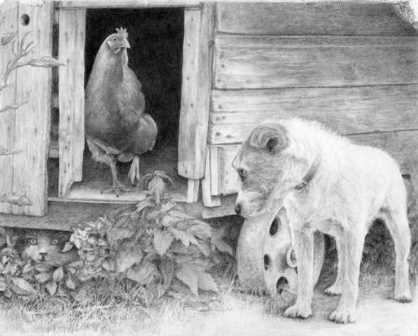
Here his another beautiful drawing that crossed my path from another artist. The best thing about drawings is that it takes away dealing with the complexities of color. So, an image in black and white and grey is all about mark-making, form, subtle textures and contrasts. And one of the most important contrasts is that of pure black and pure white. They both need to be savored and put to work very carefully.
Darks can be your friend or your enemy in a painting, and controlling black shapes will show mastery of an image. Out-of-control blacks only show how the image bossed around the artist. Putting black to use effectively can be an artists’ most powerful tool. In this image, the darkest shapes (and highest contrast) are around the doorway, a few spots of black in the wheel and against the dog’s tummy. (red arrows)
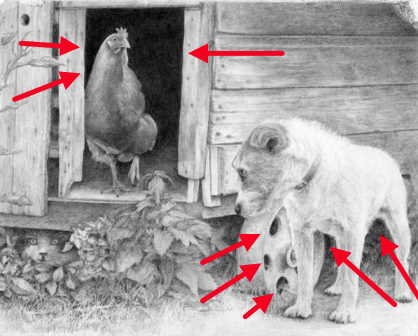
Are these areas most important to any story that could happen here? Because the human eye is a lazy organ and is drawn automatically to sharp edges and darkest blacks. (Go above and look at the original again and notice how those black shapes jump out at ya now…. funny huh? ) This artist wants to tell a story between the chicken and the dog. So how can darks be put to better use to show that story?
The black shape against the doorway was pulling all the attention. So the doorway had become the star of the image here, not the chicken. This is an easy pit to fall into. Photo references show a black doorway with a sharp edge, so we paint or draw that. But we, as artists, are not locked into that- right? We can make our paintings bend to our will….it’s a power trip!

In this version above, the edges on the doorway are softened through a slightly darker value and the sharpest edge and blackest black is now surrounding and up against the chicken. Now he is the lead, your eye looks there first. He has such a great, almost arrogant stance, and this change (although subtle) reinforces that.
But the intention of the artist is about the relationship between the chicken and the dog. An unspoken communication. So the dog needs some attention too. So instead of the wheels having those precious black spots, how about the dog? The dog’s face is getting a bit lost against the wall as well because there is not enough contrast to make him stand out since the blacks under his body were pulling attention…
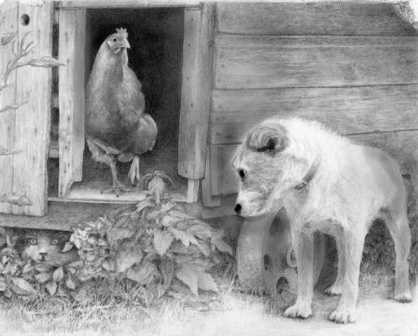
In this version above, the pure black spots went into the dog’s face- ear, eye and nose – the barn wall was slightly darkened around his silhouette to set him off from the wall, and the dark contrasts in the wheel and under his tummy were softened through softer edges and lighter values. Now we notice his head. There you are puppy!
I am a big believer in using diagonals to help bring purpose to a work. Well-placed diagonals can link elements, point to areas of focus and can overall strengthen the composition. So in the following version, I added slightly darker values to reinforce the invisible diagonal line between the chicken and the dog. Like this….
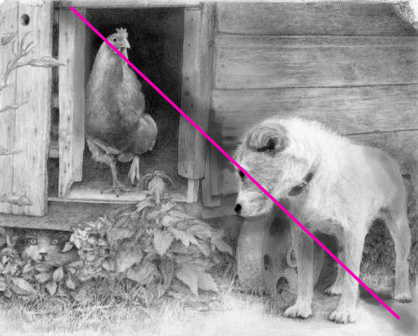
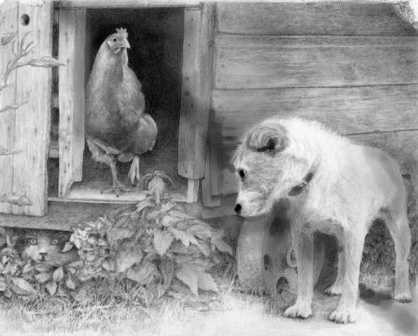
Can you see the subtle diagonal now running between them? From one eye to another. This “line” extends down to the bottom right corner and above the chicken too. This is what I call a “reinforcement” of the story. It’s ok that there wasn’t a darker smudge on the wall in the original reference. Adding it helps to link them.
And do we know the entire story here? How many of you saw this…..
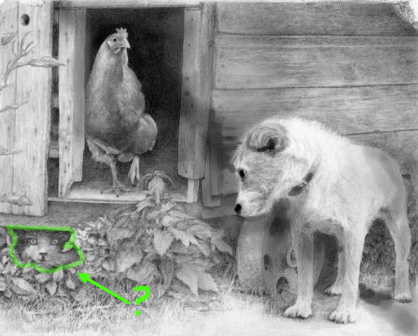
Ah ha! There is a cat hiding here…..this proves how “de-emphasizing” an area with low contrast can be put to good use. It was kind of fun when I finally saw this cat. And I didn’t see it right away. It adds to the story, no? Is the chicken protecting the cat? Is the dog trying to find the cat? And so on….. So the artist can now decide to keep the painting this way hoping the viewer will be surprised when they find the cat, or create a triad through diagonals to make the viewer look around at the 3 main players. So many options here. And no one way is the “correct” way. Just find a way!
Here they are together, before and after, for side by side reference …


So, take control of your paintings! Find your focus and intentions first, then develop the rest from there. Happy Painting!
More about control of a painting next week…..

Thanks
🙂
Excellent Christine!
thanks! 🙂
🙂
Very helpful and entertaining article! Thanks, Christine!
sure thing!
Brilliant! I’m working on some graphite drawings and this really pulled me up short! I need to frame it and reread regularly.
🙂
Good teaching! I learned needed lesson. Thanks.
sure! 🙂
🙂
This is a super excellent example about focus and control. Thank you!!
:). A good lesson for everyone. You have very nice technique and control of the medium in your work. Streamline your intentions and include very clear focus areas and your work will only get better.